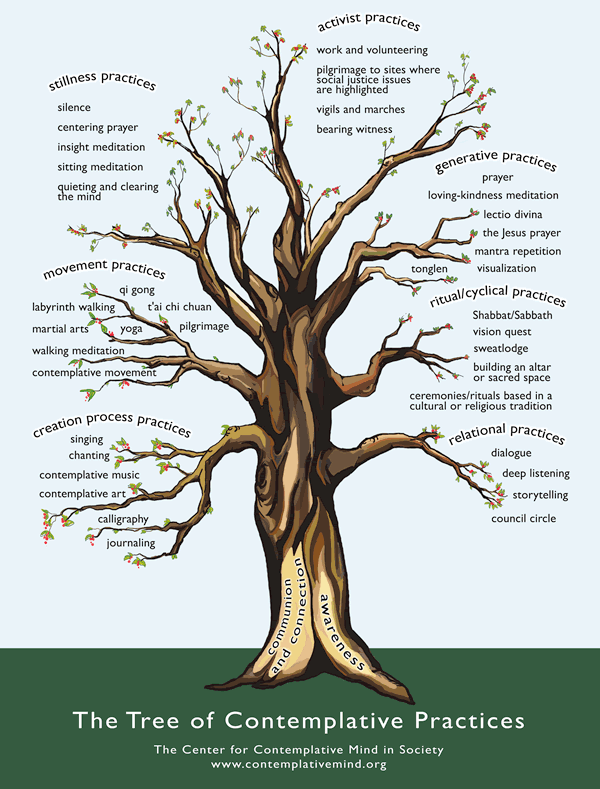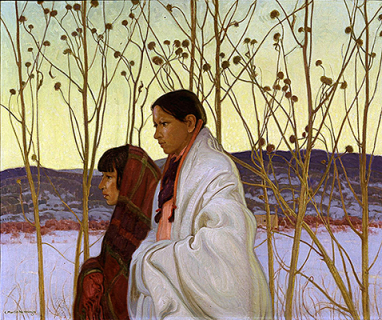In you are natural powers. You already possess everything necessary to become great.
–Chief Crow
The above quotation hangs over the sink in our kitchen, a quiet touchstone for a truth so easily forgotten. It’s a message I want to pass along to every young person (and adult) I work with. It’s also a reminder I often need myself.
So much of what we do—at the school where I work and in our culture at large—leads us away from the wisdom we carry within. We tell our kids and each other that we have to learn more before anyone will take us seriously. Experts have the answers. We think others and outside events control the way we feel. We work to tap meaning from the dried-out shells of a culture that has been co-opted by corporations. Rarely do we notice—yet alone resist—such notions. We buy the superficial slop we’re being sold and turn right around and sell it to others. We fall for the lies. We move even further from our inner guidance.
When I noticed Chief Crow’s words again this week, a few questions called out:
- Why don’t we turn to our inner wisdom more often?
- If we were to make an active connection more often, what might our lives look like?
- Assuming that it would be a good thing, how can we transition from Point A—from the surface-oriented society we are now—to Point B, the deeper, inner-guided community we want to be?
I’ll take them on one at time….
Why don’t we turn to our inner wisdom more often?
1. So many forces lead us away from looking inside, from making space for internal guidance. For one, we’re unexperienced and uneasy with listening for it. When things get too quiet—or to make sure they don’t—our society serves up stimulation around every corner. The extroverts among us think the introverts shy, hesitant, or otherwise odd. Taking time alone seems anti-social. We’re also told that our inner leanings aren’t trustworthy. Intuition floats to us on a woo-woo cloud, they say. We’d do better to follow the sound surgical logic that comes from external reasoning. In addition, most of us lack role models to show us how to turn inward. When friends, colleagues, and everyone around us seems to live their lives on the surface, how can we know what’s possible? Maybe we get an inkling or feel a longing—an impulse flares—but we have no idea how to follow it up. In that vacuum, the flicker fades.
2. Most of us also spend our time in the overlapping trances of consumption, technology, and obligation. We try to stay conscious but get pulled into the vortex of celebrity gossip, sports results, and media-made controversy. We spin ever faster to keep up with the latest news, the trending Twitter feeds, and the crazy cats and epic fails of YouTube. Our work schedules compound with our “entertainment” demands and available time shrinks to nothing. Those with children struggle to even remember what a free moment feels like. We intend to trim the distractions away, but we rarely do.
To some extent, such addiction has developed by design. Advertisers leverage our genetic history and neuroscientific coding to draw our attention outward. We turn to shiny things almost automatically—is that a threat on the landscape? is this a potential partner? what beauty!—and reinforce the short-term rush of sugar, shopping, and caffeine. We long for real intimacy but get seduced by the siren song of sexual titillation. If only we could be slimmer, stronger, more striking. If only, we lament, and the outward pull continues.
3. Even those of us with the intention of turning inward often lack the community to support doing so. We talk with colleagues about the affairs of the day rather than finding friends who follow the tracks of our hearts. Our conversations become snippier and snarkier, more focused on the clever quip than the patient insight. We rarely notice how our friendships drift toward correction, skepticism, and advice-giving—none of which helps welcome the hesitant soul out of its hidden thicket.
4. More than anything, I contend that we avoid our inner landscape because we’re afraid of what we’ll find. If I stop to breathe and to notice what’s really going on inside, I may see that, even with a generous circle of friends and a lovely life partner, I still feel lonely. I may notice deep sadness for a past relationship or for my own lost potential. Maybe I fear for the future of the planet in the face of ecological and political threats. Or maybe I’m angry with myself for having denied my truest desires or with the world for continuing violence and injustice. An honest look below the surface can bring unsavory qualities or tendencies to light—maybe I’m not the man I hoped I was. Maybe I’m an impostor. And while new insights from turning the searchlight inward can prove helpful, they can also make demands of their own. The genie won’t go back in the bottle. He’ll make us take responsibility for our wishes.
If we were to make an active connection with our inner world more often, what might our daily lives look like?
To start, we would have more open space in our schedules. A relationship with the inner world needs space for wandering and wondering. That’s true in a literal sense, physically getting ourselves outside to move about, and it’s true in a metaphorical sense as well. We need free time. We need enough quiet to hear our intuitive guidance.
In addition, we would nurture and support paths that bring inner wisdom out into the world. We’d teach kids (and adults) the many paths of contemplation, our classes would include the subjective perspective that asks “What stirs in me in response to this subject matter?,” and we’d reinforce the value of silence. We’d encourage creative expression in any format—painting, drawing, ceramics, dance, music, theater—that calls forward native intelligence. Coaches for sports and other athletic endeavors would offer instruction in mental alignment and conscious breathwork, much as happens in the multiple branches of yoga.

One can find many paths inward on the tree of contemplative practices.
…..
Image courtesy of the Center for Contemplative Mind in Society.
We would set healthy boundaries with (and sometimes against) the many forces that pull us away from that inner groundedness. How many advertisements do we consume? How much time do we interact with screens? When and where will we answer our cell phones or respond to text messages? The ideal need not require cold turkey withdrawal, but it most certainly demands conscious choice-making rather than a hazy drift into addictive entertainment or outer-world stimulation. We need to be in conversation with these demons, perhaps inviting them for a cup of tea–but without letting them take over the house.
We would seek and build genuine circles of community. Like the Circles of Trust workshops offered by the Center for Courage and Renewal, we’d seek ‘communities of solitude’ where each member recognizes the inherent wisdom of the other members. Rather than trying to fix or advise anyone else, we’d work to invite deeper self-reflection. Honest and open questions—the kinds we actually don’t know the answer to—would serve a spirit of inquiry rather than drifting toward debate or dialogue. Your soul knows what you need more than I could ever guess.

Acknowledging clouds of feeling allows the blue sky to re-emerge.
…..
Photo courtesy of Wikimedia Commons.
We would acknowledge and allow the full range of our feelings. Ignoring, denying, or stuffing emotional responses doesn’t make them go away. On the contrary, it leaves them to fester and poison the rest of our lives. If we allow ourselves to honestly feel the isolation, the fear, and the self-doubt—and even better if we share it with other open-minded souls—we begin to build connection, generate courage, and stir new confidence. We see that the walls we’d built to fend off our fears and frustrations had been sealing off our joys as well. Grey clouds clear to blue skies. Our lethargy flushes away and new energies start to surge through us.
Maybe most importantly, we adults would practice what we preach, making sure to pursue these paths ourselves—and to let others know about our experiences. We would need to challenge our chock-full schedules, slow the pace of our consumptive ambitions, and enter the cave of our own feeling-worlds. It’s far easier to talk about the need to go inward than it is to actually go inward.[1] Get to the yoga mat. Sit for meditation. Write in the journal. Breathe. And then trust that we have everything we need. Those around us will notice our congruence. Those receiving from us will appreciate our consistency.
Assuming that it would be a good thing, how can we transition from Point A—from the surface-oriented society we are now—to Point B, the deeper, inner-guided community we want to be?
1. Note the issue. The first step in addressing any problem is to admit that there is a problem. So many of us feel this separation from our inner lives without even consciously registering it. As author and facilitator Parker Palmer says, we long for undivided lives. Trouble is, we usually don’t recognize our ‘tragic gap,’ the distance between what we do and who we truly are. Without the diagnosis, we won’t ever find the remedy.
2. Name the desire for something different. Once we’ve found the root of our suffering, we can start to articulate what we’d want in its place. This post outlines some of what I’d love to build into and around my life. I imagine you’d want your own way of connecting with your inner world. When we declare our intentions clearly, the universe conspires (“breathes-with”) on our behalf. Opportunities arise. Unanticipated solutions emerge.
3. Ask great questions. Honest inquiry has great power. We need not know every answer for how to proceed from Point A to Point B. Honest, skillful questions have a magnetic power of their own. They draw allies towards us and they loosen the soil for new growth. They encourage curiosity and humility, two essential qualities for effective change-making. How do we build a relationship with our inner worlds? I don’t know for sure, but I know that I’ll enjoy the exploration.
4. Pay attention. Once we’ve seeded our fields with great questions, we need to listen and watch carefully for the responses that come back our way. This may mean carving out quiet time or temporarily shutting off the spigot of information flowing into our lives. Or it may simply mean waking up amidst the hubbub we find ourselves in. Either way, we tune our awareness in preparation for the answers coming in.

One step at a time can lead to beautiful places.
…..
Photo courtesy of Wikimedia Commons.
5. Take little steps. We can admit and accept that change may not happen overnight. We likely won’t shake the sleep off our eyes to learn that we’re suddenly undivided no more. Instead, we can find ways—little ways, incremental ways—to support moving in this direction. We can celebrate our own choices that reestablish connection with our inner lives. And we can honor those who make such choices around us. You remembered to close your eyes and to check just how hungry you actually were before plowing into the lunch buffet? Good work. I took five minutes of silence before leaping into my day? Nicely done. Each small step adds more to the great journey.
6. Seek the new skills we need. Again, most of us haven’t had practice for turning inward. We haven’t seen role models. There’s no shame in admitting that we’ll have to learn. Try a mindfulness meditation class. Head to a yoga studio. Take a Deep Listening workshop. Train with a positive reinforcement instructor. Jump into an improvisational theater group. Stretch your body and your mind in ways that honor your own wisdom and forge your self-integrity.
7. Find allies. The Buddha recommended that, before ever stepping onto the Eight-Fold Path toward ending suffering, we should establish Right Association—hanging with the proper posse. The kind of work we’re proposing here invites big change in established systems that actively resist change. As one friend recently noted, “The system is most interested in seeing the system continue.” Who can support our vision? Who sees past our blind spots? Who can make us laugh? Who has the emotional depth, maturity, and curiosity to hold the weight and wonder of what we find when we turn inward? These are the friends we need. These are the allies we seek.
[1] Trust me, I know. This particular blog post has, ironically, taken more time to write than any other I’ve taken on. The persuasive pull of my outer-world dealings—some productive and some not so productive—has kept me from getting back here. One step at a time. Back on track.



Ted, wonderful insight, especially at this time of year. Thank you. I am sure it took a great deal or inner fortitude and reflection. I feel thankful that I wandered down this path.
Pat, I’m so glad you came by to take this one in. It did take a while–it’s so hard to put the walk behind the talk. I’m glad it’s out there now.
Ted, thank you so much for taking the time to write this post. It was absolutely what I needed to read right now at this precise moment in time:-) I love when that happens!
It is so easy to forget or not even begin to see what is of real value in the world. Thank you for sharing your experiences but also your advice on making small incremental changes xx
Carolyn, you’re most welcome. I’m delighted that it got to you at a helpful time. One step at a time, eh? One step at a time.
Ted,
Great post.
All too often we find that the true happiness we are looking for it just a step away, but we find it so hard to take that step.
For me, this is best summoned up with the notion of the ‘Kingdom of Heaven’, which is right here, right now, waiting for us – if we could just take the time to be still and see it.
Thanks for posting.
Stuart